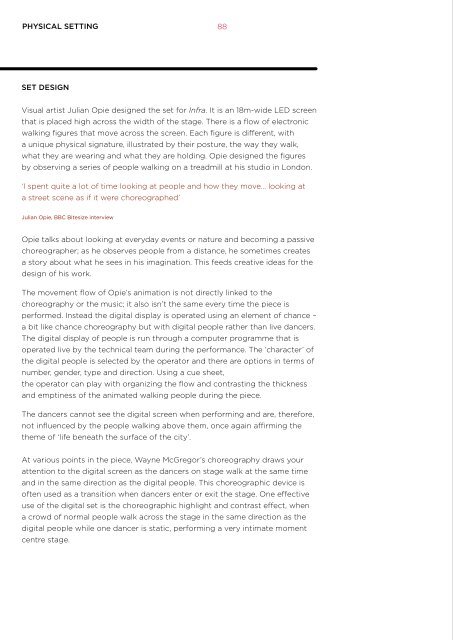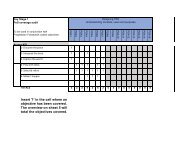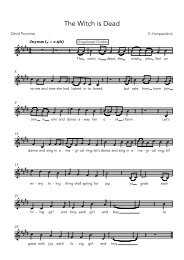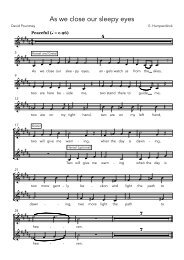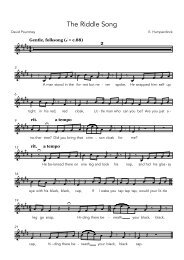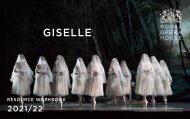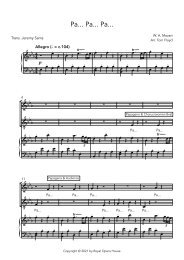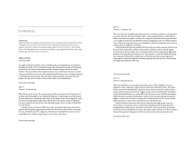Infra E-resource pack 2018
Create successful ePaper yourself
Turn your PDF publications into a flip-book with our unique Google optimized e-Paper software.
PHYSICAL SETTING<br />
88<br />
SET DESIGN<br />
Visual artist Julian Opie designed the set for <strong>Infra</strong>. It is an 18m-wide LED screen<br />
that is placed high across the width of the stage. There is a flow of electronic<br />
walking figures that move across the screen. Each figure is different, with<br />
a unique physical signature, illustrated by their posture, the way they walk,<br />
what they are wearing and what they are holding. Opie designed the figures<br />
by observing a series of people walking on a treadmill at his studio in London.<br />
‘I spent quite a lot of time looking at people and how they move… looking at<br />
a street scene as if it were choreographed’<br />
Julian Opie, BBC Bitesize interview<br />
Opie talks about looking at everyday events or nature and becoming a passive<br />
choreographer; as he observes people from a distance, he sometimes creates<br />
a story about what he sees in his imagination. This feeds creative ideas for the<br />
design of his work.<br />
The movement flow of Opie’s animation is not directly linked to the<br />
choreography or the music; it also isn’t the same every time the piece is<br />
performed. Instead the digital display is operated using an element of chance –<br />
a bit like chance choreography but with digital people rather than live dancers.<br />
The digital display of people is run through a computer programme that is<br />
operated live by the technical team during the performance. The ‘character’ of<br />
the digital people is selected by the operator and there are options in terms of<br />
number, gender, type and direction. Using a cue sheet,<br />
the operator can play with organizing the flow and contrasting the thickness<br />
and emptiness of the animated walking people during the piece.<br />
JULIAN OPIE INSPIRED STUDENT OBSERVATION TASK<br />
+ + Go to a public space within your school environment with<br />
a notebook and pen<br />
+ + Stand or sit alone, some distance away from the main activity<br />
(close enough to see the activity but far enough away so you are<br />
unable to hear any conversations)<br />
+ + Listen to a piece of instrumental music of your choice through<br />
headphones (optional)<br />
+ + Zone in on one particular area of the space and observe the<br />
interactions and movement activities that happen in that space<br />
over a duration of 5 minutes<br />
+ + While observing make notes of:<br />
Entrances and exits<br />
Actions<br />
Use of space (pathways and levels)<br />
Relationships<br />
Dynamics of the movements that you see<br />
+ + Can you write a narrative for what you saw?<br />
+ + Use some of your notes as a starting point for a choreographic<br />
exploration in your dance class<br />
The dancers cannot see the digital screen when performing and are, therefore,<br />
not influenced by the people walking above them, once again affirming the<br />
theme of ‘life beneath the surface of the city’.<br />
At various points in the piece, Wayne McGregor’s choreography draws your<br />
attention to the digital screen as the dancers on stage walk at the same time<br />
and in the same direction as the digital people. This choreographic device is<br />
often used as a transition when dancers enter or exit the stage. One effective<br />
use of the digital set is the choreographic highlight and contrast effect, when<br />
a crowd of normal people walk across the stage in the same direction as the<br />
digital people while one dancer is static, performing a very intimate moment<br />
centre stage.


